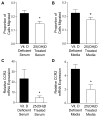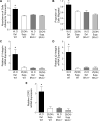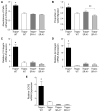25(OH) vitamin D suppresses macrophage adhesion and migration by downregulation of ER stress and scavenger receptor A1 in type 2 diabetes
- PMID: 24184871
- PMCID: PMC4026336
- DOI: 10.1016/j.jsbmb.2013.10.016
25(OH) vitamin D suppresses macrophage adhesion and migration by downregulation of ER stress and scavenger receptor A1 in type 2 diabetes
Abstract
Cardiovascular disease (CVD) is the leading cause of mortality in patients with type 2 diabetes mellitus (T2DM). Vitamin D deficiency is not only more prevalent in diabetics but also doubles the risk of developing CVD. However, it is unknown whether 25-hydroxy vitamin D [25(OH)D3] replacement slows monocyte adhesion and migration, critical mechanisms involved in atherosclerosis progression. In this study, monocytes from vitamin D-deficient diabetic patients were cultured either in the patient's serum or in vitamin D-deficient media with or without 25(OH)D3 treatment. Adding 25(OH)D3 to monocytes cultured in vitamin D-deficient serum or media decreased monocyte adhesion to fibronectin and migration stimulated by monocyte chemotactic protein 1 (MCP-1). Accordingly, 25(OH)D3 decreased adhesion marker β1- and β2-integrin expression and migration receptor chemokine (C-C motif) receptor 2 (CCR2) expression. 25(OH)D3 treatment downregulated monocyte endoplasmic reticulum (ER) stress and scavenger receptor class A, type 1 (SR-A1) expression. The absence of SR-A1 prevented the increased macrophage adhesion and migration induced by vitamin D deficiency. Moreover, the absence of SR-A1 prevented the induction of adhesion and migration and expression of their associated membrane receptors by Thapsigargin, an ER stress inducer. These results identify cellular activation of monocyte/macrophage vitamin D signaling through 25(OH)D3 as a potential mechanism that could modulate adhesion and migration in diabetic subjects. This article is part of a Special Issue entitled '16th Vitamin D Workshop'.
Keywords: Adhesion; Diabetes; Macrophage; Migration; SR-A1; Vitamin D.
Copyright © 2013 Elsevier Ltd. All rights reserved.
Figures





Similar articles
-
1,25(OH)2 vitamin D suppresses macrophage migration and reverses atherogenic cholesterol metabolism in type 2 diabetic patients.J Steroid Biochem Mol Biol. 2013 Jul;136:309-12. doi: 10.1016/j.jsbmb.2012.12.019. Epub 2013 Jan 17. J Steroid Biochem Mol Biol. 2013. PMID: 23333932 Free PMC article. Review.
-
Vitamin D suppression of endoplasmic reticulum stress promotes an antiatherogenic monocyte/macrophage phenotype in type 2 diabetic patients.J Biol Chem. 2012 Nov 9;287(46):38482-94. doi: 10.1074/jbc.M112.386912. Epub 2012 Sep 24. J Biol Chem. 2012. PMID: 23012375 Free PMC article.
-
1,25(OH)2 vitamin d inhibits foam cell formation and suppresses macrophage cholesterol uptake in patients with type 2 diabetes mellitus.Circulation. 2009 Aug 25;120(8):687-98. doi: 10.1161/CIRCULATIONAHA.109.856070. Epub 2009 Aug 10. Circulation. 2009. PMID: 19667238 Free PMC article.
-
Vitamin D3 supplementation decreases a unique circulating monocyte cholesterol pool in patients with type 2 diabetes.J Steroid Biochem Mol Biol. 2018 Mar;177:187-192. doi: 10.1016/j.jsbmb.2017.09.011. Epub 2017 Sep 21. J Steroid Biochem Mol Biol. 2018. PMID: 28941998 Free PMC article. Clinical Trial.
-
Vitamin D regulates macrophage cholesterol metabolism in diabetes.J Steroid Biochem Mol Biol. 2010 Jul;121(1-2):430-3. doi: 10.1016/j.jsbmb.2010.03.018. Epub 2010 Mar 23. J Steroid Biochem Mol Biol. 2010. PMID: 20338238 Review.
Cited by
-
Vitamin D3 Induces Gene Expression of Ox-LDL Scavenger Receptors in Streptozotocin-Induced Diabetic Rat Aortas: New Insight into the Role of Vitamin D in Diabetic Atherosclerosis.Rep Biochem Mol Biol. 2018 Apr;6(2):170-177. Rep Biochem Mol Biol. 2018. PMID: 29766000 Free PMC article.
-
The Big Vitamin D Mistake.J Prev Med Public Health. 2017 Jul;50(4):278-281. doi: 10.3961/jpmph.16.111. Epub 2017 May 10. J Prev Med Public Health. 2017. PMID: 28768407 Free PMC article.
-
Potential impact of the steroid hormone, vitamin D, on the vasculature.Am Heart J. 2021 Sep;239:147-153. doi: 10.1016/j.ahj.2021.05.012. Epub 2021 May 27. Am Heart J. 2021. PMID: 34051171 Free PMC article. Review.
-
Endoplasmic reticulum stress: a novel mechanism and therapeutic target for cardiovascular diseases.Acta Pharmacol Sin. 2016 Apr;37(4):425-43. doi: 10.1038/aps.2015.145. Epub 2016 Feb 1. Acta Pharmacol Sin. 2016. PMID: 26838072 Free PMC article. Review.
-
Successful Treatment of Severe Atopic Dermatitis with Calcitriol and Paricalcitol in an 8-Year-Old Girl.Case Rep Pediatr. 2018 Jun 24;2018:9643543. doi: 10.1155/2018/9643543. eCollection 2018. Case Rep Pediatr. 2018. PMID: 30034905 Free PMC article.
References
-
- National diabetes fact sheet: general information and national estimates on diabetes in the United States. Centers for Disease Control and Prevention; 2011. pp. 1–12.
-
- National Diabetes Statistics; N.I.o. Health, editor. NIH publication 08-3892. 2007. pp. 1–24.
-
- Binder CJ, Chang MK, Shaw PX, Miller YI, Hartvigsen K, Dewan A, Witztum JL. Innate and acquired immunity in atherogenesis. Nat Med. 2002;8(11):1218–1226. - PubMed
Publication types
MeSH terms
Substances
Grants and funding
LinkOut - more resources
Full Text Sources
Other Literature Sources
Medical
Research Materials
Miscellaneous

